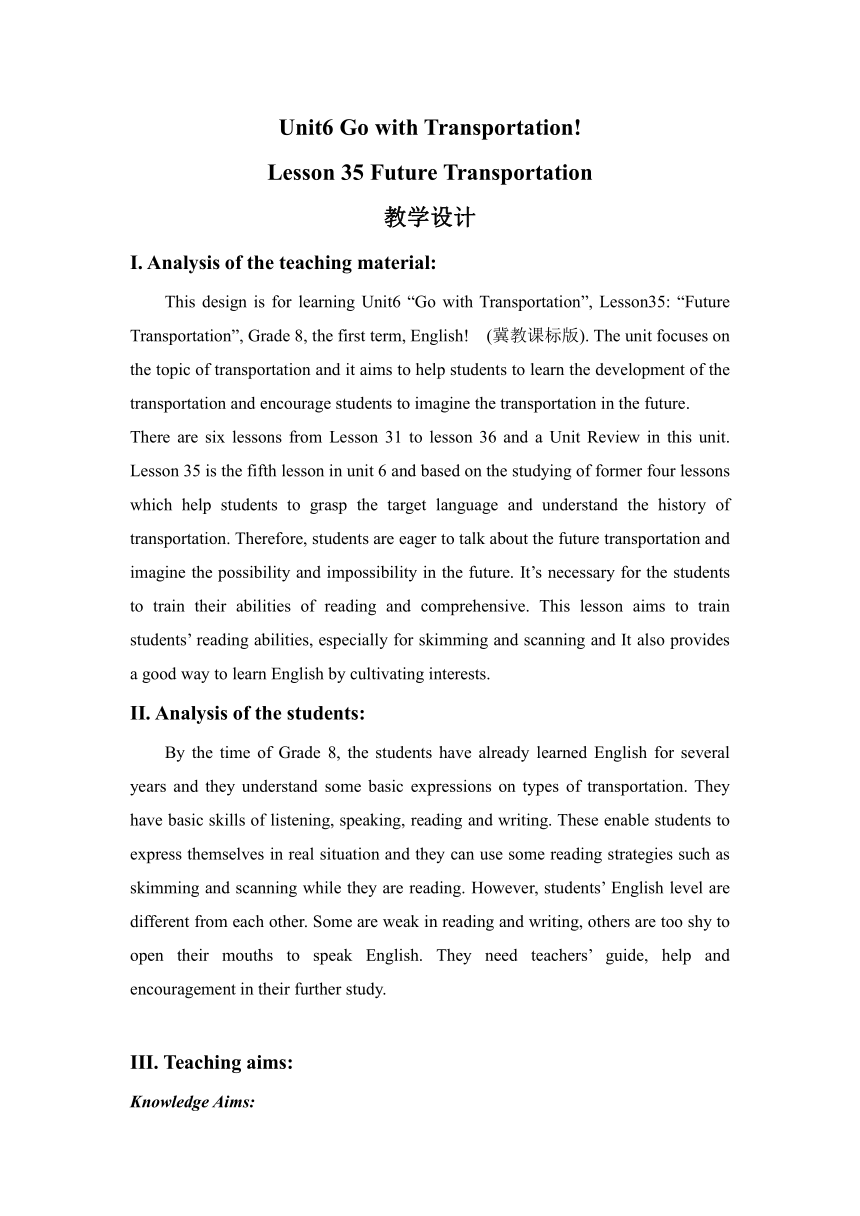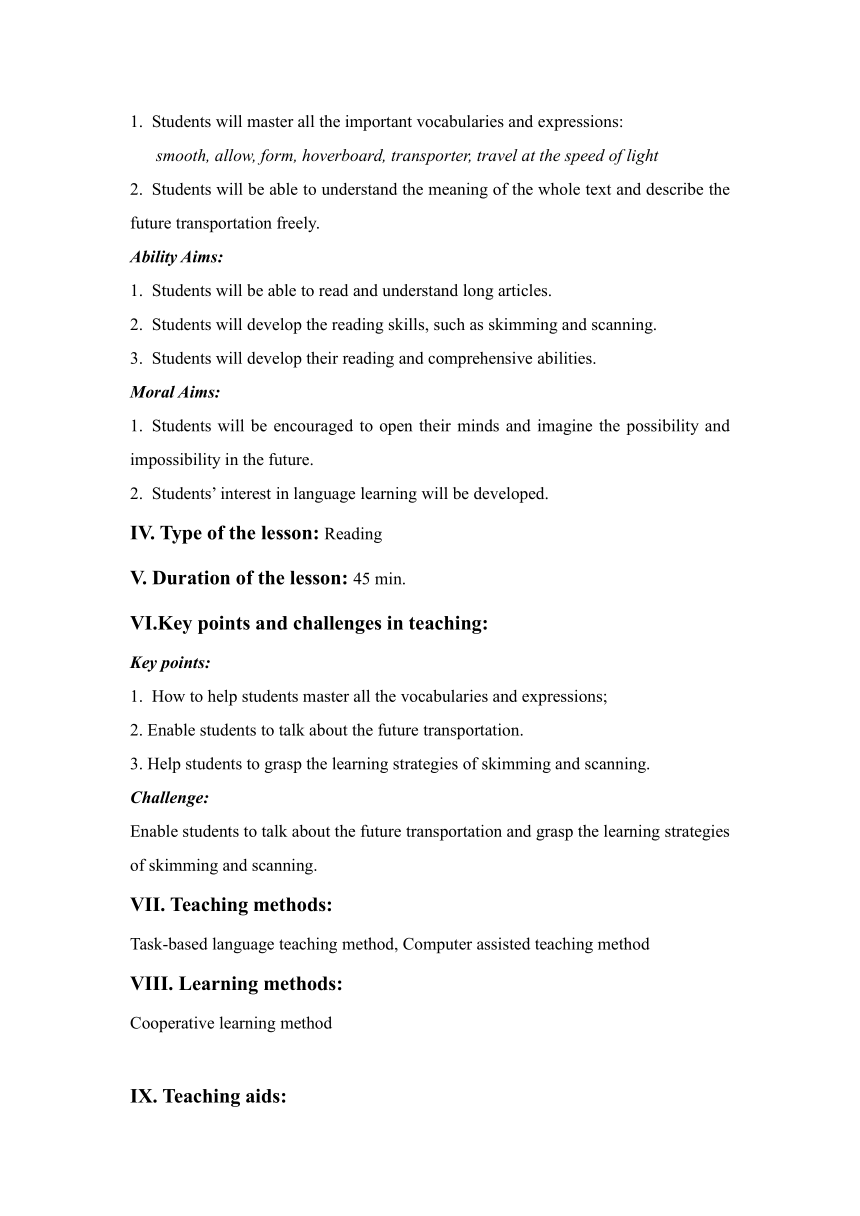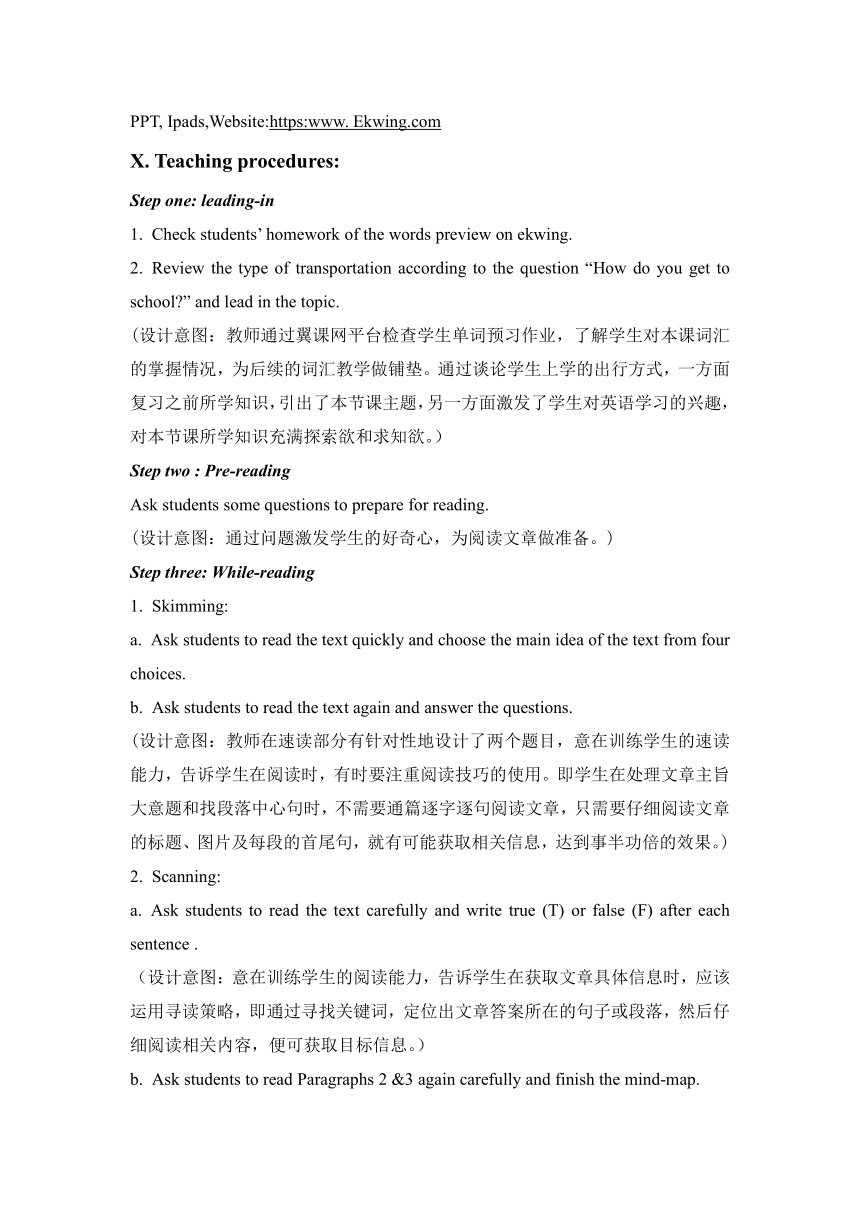Lesson 35 Future Transportation 教案
文档属性
| 名称 | Lesson 35 Future Transportation 教案 |  | |
| 格式 | doc | ||
| 文件大小 | 39.0KB | ||
| 资源类型 | 教案 | ||
| 版本资源 | 冀教版 | ||
| 科目 | 英语 | ||
| 更新时间 | 2022-08-27 20:28:44 | ||
图片预览



文档简介
Unit6 Go with Transportation!
Lesson 35 Future Transportation
教学设计
I. Analysis of the teaching material:
This design is for learning Unit6 “Go with Transportation”, Lesson35: “Future Transportation”, Grade 8, the first term, English! (冀教课标版). The unit focuses on the topic of transportation and it aims to help students to learn the development of the transportation and encourage students to imagine the transportation in the future.
There are six lessons from Lesson 31 to lesson 36 and a Unit Review in this unit. Lesson 35 is the fifth lesson in unit 6 and based on the studying of former four lessons which help students to grasp the target language and understand the history of transportation. Therefore, students are eager to talk about the future transportation and imagine the possibility and impossibility in the future. It’s necessary for the students to train their abilities of reading and comprehensive. This lesson aims to train students’ reading abilities, especially for skimming and scanning and It also provides a good way to learn English by cultivating interests.
II. Analysis of the students:
By the time of Grade 8, the students have already learned English for several years and they understand some basic expressions on types of transportation. They have basic skills of listening, speaking, reading and writing. These enable students to express themselves in real situation and they can use some reading strategies such as skimming and scanning while they are reading. However, students’ English level are different from each other. Some are weak in reading and writing, others are too shy to open their mouths to speak English. They need teachers’ guide, help and encouragement in their further study.
III. Teaching aims:
Knowledge Aims:
1. Students will master all the important vocabularies and expressions:
smooth, allow, form, hoverboard, transporter, travel at the speed of light
2. Students will be able to understand the meaning of the whole text and describe the future transportation freely.
Ability Aims:
1. Students will be able to read and understand long articles.
2. Students will develop the reading skills, such as skimming and scanning.
3. Students will develop their reading and comprehensive abilities.
Moral Aims:
1. Students will be encouraged to open their minds and imagine the possibility and impossibility in the future.
2. Students’ interest in language learning will be developed.
IV. Type of the lesson: Reading
V. Duration of the lesson: 45 min.
VI.Key points and challenges in teaching:
Key points:
1. How to help students master all the vocabularies and expressions;
2. Enable students to talk about the future transportation.
3. Help students to grasp the learning strategies of skimming and scanning.
Challenge:
Enable students to talk about the future transportation and grasp the learning strategies of skimming and scanning.
VII. Teaching methods:
Task-based language teaching method, Computer assisted teaching method
VIII. Learning methods:
Cooperative learning method
IX. Teaching aids:
PPT, Ipads,Website:https:www.
X. Teaching procedures:
Step one: leading-in
1. Check students’ homework of the words preview on ekwing.
2. Review the type of transportation according to the question “How do you get to school ” and lead in the topic.
(设计意图:教师通过翼课网平台检查学生单词预习作业,了解学生对本课词汇的掌握情况,为后续的词汇教学做铺垫。通过谈论学生上学的出行方式,一方面复习之前所学知识,引出了本节课主题,另一方面激发了学生对英语学习的兴趣,对本节课所学知识充满探索欲和求知欲。)
Step two : Pre-reading
Ask students some questions to prepare for reading.
(设计意图:通过问题激发学生的好奇心,为阅读文章做准备。)
Step three: While-reading
1. Skimming:
a. Ask students to read the text quickly and choose the main idea of the text from four choices.
b. Ask students to read the text again and answer the questions.
(设计意图:教师在速读部分有针对性地设计了两个题目,意在训练学生的速读能力,告诉学生在阅读时,有时要注重阅读技巧的使用。即学生在处理文章主旨大意题和找段落中心句时,不需要通篇逐字逐句阅读文章,只需要仔细阅读文章的标题、图片及每段的首尾句,就有可能获取相关信息,达到事半功倍的效果。)
2. Scanning:
a. Ask students to read the text carefully and write true (T) or false (F) after each sentence .
(设计意图:意在训练学生的阅读能力,告诉学生在获取文章具体信息时,应该运用寻读策略,即通过寻找关键词,定位出文章答案所在的句子或段落,然后仔细阅读相关内容,便可获取目标信息。)
b. Ask students to read Paragraphs 2 &3 again carefully and finish the mind-map.
(设计意图:学生在掌握寻读方法的基础上,进行进一步巩固练习。通过逐段阅读,了解文章细节,学习新单词和语言点。)
Step four: after-reading
1. Let students repeat the lesson by following the record on .
2. Check students’ oral practice on ekwing and encourage students to read the text loudly after reading.
(设计意图:对学生进行读后的口语朗读训练,一方面可以帮助学生进一步理清文章思路,另一方面训练学生的发音、语音和语调等口语细节问题,鼓励学生课后多练习口语。)
3. Ask students to think about the question: What are the common features (共性) between the hoverboards and transporters
(设计意图:通过设计问题,拓宽学生思维的广度和深度,提高学生的思维品质。 鼓励学生不要只局限于课文内容,应该开拓思维,大胆想象,为后面的大组活动做好准备。)
Step five: Groupwork
1. Encourage students to use their imagination to create a new kind of transportation. Ask students to draw a picture and describe their invention in English.
(设计意图:培养学生综合运用语言的能力,进一步鼓励学生开拓思维,大胆想象,并勇于将想法付诸实践。)
2. Provide some useful questions to help students to finish the task.
(设计意图:为学生下一环节的汇报展示提供思路和语料库。)
3. Ask three groups of students to show their new types of transportation in front of the class. Encourage students to open their mind and imagine new things as much as possible.
(设计意图:训练学生的语言综合运用能力,激发学生英语学习的兴趣,鼓励学生大胆展示自我,培养他们的自信心。)
Step six: Summary and homework.
1. Write a passage about “Future transportation” according to the report in this class.
(设计意图:将本节课的学习成果,整理成小短文,在训练学生听、说、读的基础上,进一步训练学生的写作能力。)
2. Finish the reading exercise on .
(设计意图:练习和巩固本节课所学阅读技巧,提高学生的阅读能力。)
XI. Blackboard design
XII. Self-reflection
本节课基本达成教学目标,学生不仅可以对未来的交通工具展开丰富想象,运用目标语言及简单的英文表达来描述未来交通工具的特征,而且学生的阅读能力得到训练,速读和寻读技巧得到进一步强化。
本节课的亮点在于,教师将传统的英语课堂教学与现代化信息技术相联系,借助翼课网平台,做到精准教学,提高课堂效率。在本节课开始,教师通过检查翼课网预习单词的作业,了解学生对本课单词的掌握情况,在词汇教学中做到胸有成竹,对学生掌握不熟练的词汇在课堂教学中进行重点强化。学生完成阅读训练之后,教师及时在翼课网上布置课堂作业,让学生大声朗诵课文,一方面巩固本节课所学内容,另一方面训练了学生口语。学生的学习情况通过网络得到及时反馈,能够有效帮助教师进行个性化、差异化教学。教师通过播放优秀学生课堂录音,鼓励学生课后勤练口语,提高语言的实际应用能力。此外,本节课课堂导入自然,教师联系学生生活实际,通过展示班里个别同学上学所用交通工具的图片,谈论学生的日常出行方式,一方面活跃了课堂氛围,提高学生英语学习兴趣,另一方面复习巩固之前所学知识,并有效导出本节课主题,为本节课的阅读教学做好铺垫。
但是,本节课也存在一些不足之处,教师在教授新单词“hoverboard”时,发现PPT有一处拼写错误,虽然在课堂上进行了及时改正,但给了学生错误引导,教师应在平时备课上多下功夫。在小组活动环节,部分英语基础较差、口语较弱的同学,无法参与到小组活动中去,显得不知所措。教师在平常设计小组活动时,应该充分考虑到学生的个性化差异,分层教学,设计有梯度的小组任务,尽量让更多的学生参与进去,让学生在小组活动中找到自信,从而提高英语学习的兴趣。
Lesson35 Future Transportation
Transportation
Go to school on foot hoverboard
Walk transporter
Take a subway smooth
Go to school by subway at the speed of...
Ride a bike
Go to school by bike
Lesson 35 Future Transportation
教学设计
I. Analysis of the teaching material:
This design is for learning Unit6 “Go with Transportation”, Lesson35: “Future Transportation”, Grade 8, the first term, English! (冀教课标版). The unit focuses on the topic of transportation and it aims to help students to learn the development of the transportation and encourage students to imagine the transportation in the future.
There are six lessons from Lesson 31 to lesson 36 and a Unit Review in this unit. Lesson 35 is the fifth lesson in unit 6 and based on the studying of former four lessons which help students to grasp the target language and understand the history of transportation. Therefore, students are eager to talk about the future transportation and imagine the possibility and impossibility in the future. It’s necessary for the students to train their abilities of reading and comprehensive. This lesson aims to train students’ reading abilities, especially for skimming and scanning and It also provides a good way to learn English by cultivating interests.
II. Analysis of the students:
By the time of Grade 8, the students have already learned English for several years and they understand some basic expressions on types of transportation. They have basic skills of listening, speaking, reading and writing. These enable students to express themselves in real situation and they can use some reading strategies such as skimming and scanning while they are reading. However, students’ English level are different from each other. Some are weak in reading and writing, others are too shy to open their mouths to speak English. They need teachers’ guide, help and encouragement in their further study.
III. Teaching aims:
Knowledge Aims:
1. Students will master all the important vocabularies and expressions:
smooth, allow, form, hoverboard, transporter, travel at the speed of light
2. Students will be able to understand the meaning of the whole text and describe the future transportation freely.
Ability Aims:
1. Students will be able to read and understand long articles.
2. Students will develop the reading skills, such as skimming and scanning.
3. Students will develop their reading and comprehensive abilities.
Moral Aims:
1. Students will be encouraged to open their minds and imagine the possibility and impossibility in the future.
2. Students’ interest in language learning will be developed.
IV. Type of the lesson: Reading
V. Duration of the lesson: 45 min.
VI.Key points and challenges in teaching:
Key points:
1. How to help students master all the vocabularies and expressions;
2. Enable students to talk about the future transportation.
3. Help students to grasp the learning strategies of skimming and scanning.
Challenge:
Enable students to talk about the future transportation and grasp the learning strategies of skimming and scanning.
VII. Teaching methods:
Task-based language teaching method, Computer assisted teaching method
VIII. Learning methods:
Cooperative learning method
IX. Teaching aids:
PPT, Ipads,Website:https:www.
X. Teaching procedures:
Step one: leading-in
1. Check students’ homework of the words preview on ekwing.
2. Review the type of transportation according to the question “How do you get to school ” and lead in the topic.
(设计意图:教师通过翼课网平台检查学生单词预习作业,了解学生对本课词汇的掌握情况,为后续的词汇教学做铺垫。通过谈论学生上学的出行方式,一方面复习之前所学知识,引出了本节课主题,另一方面激发了学生对英语学习的兴趣,对本节课所学知识充满探索欲和求知欲。)
Step two : Pre-reading
Ask students some questions to prepare for reading.
(设计意图:通过问题激发学生的好奇心,为阅读文章做准备。)
Step three: While-reading
1. Skimming:
a. Ask students to read the text quickly and choose the main idea of the text from four choices.
b. Ask students to read the text again and answer the questions.
(设计意图:教师在速读部分有针对性地设计了两个题目,意在训练学生的速读能力,告诉学生在阅读时,有时要注重阅读技巧的使用。即学生在处理文章主旨大意题和找段落中心句时,不需要通篇逐字逐句阅读文章,只需要仔细阅读文章的标题、图片及每段的首尾句,就有可能获取相关信息,达到事半功倍的效果。)
2. Scanning:
a. Ask students to read the text carefully and write true (T) or false (F) after each sentence .
(设计意图:意在训练学生的阅读能力,告诉学生在获取文章具体信息时,应该运用寻读策略,即通过寻找关键词,定位出文章答案所在的句子或段落,然后仔细阅读相关内容,便可获取目标信息。)
b. Ask students to read Paragraphs 2 &3 again carefully and finish the mind-map.
(设计意图:学生在掌握寻读方法的基础上,进行进一步巩固练习。通过逐段阅读,了解文章细节,学习新单词和语言点。)
Step four: after-reading
1. Let students repeat the lesson by following the record on .
2. Check students’ oral practice on ekwing and encourage students to read the text loudly after reading.
(设计意图:对学生进行读后的口语朗读训练,一方面可以帮助学生进一步理清文章思路,另一方面训练学生的发音、语音和语调等口语细节问题,鼓励学生课后多练习口语。)
3. Ask students to think about the question: What are the common features (共性) between the hoverboards and transporters
(设计意图:通过设计问题,拓宽学生思维的广度和深度,提高学生的思维品质。 鼓励学生不要只局限于课文内容,应该开拓思维,大胆想象,为后面的大组活动做好准备。)
Step five: Groupwork
1. Encourage students to use their imagination to create a new kind of transportation. Ask students to draw a picture and describe their invention in English.
(设计意图:培养学生综合运用语言的能力,进一步鼓励学生开拓思维,大胆想象,并勇于将想法付诸实践。)
2. Provide some useful questions to help students to finish the task.
(设计意图:为学生下一环节的汇报展示提供思路和语料库。)
3. Ask three groups of students to show their new types of transportation in front of the class. Encourage students to open their mind and imagine new things as much as possible.
(设计意图:训练学生的语言综合运用能力,激发学生英语学习的兴趣,鼓励学生大胆展示自我,培养他们的自信心。)
Step six: Summary and homework.
1. Write a passage about “Future transportation” according to the report in this class.
(设计意图:将本节课的学习成果,整理成小短文,在训练学生听、说、读的基础上,进一步训练学生的写作能力。)
2. Finish the reading exercise on .
(设计意图:练习和巩固本节课所学阅读技巧,提高学生的阅读能力。)
XI. Blackboard design
XII. Self-reflection
本节课基本达成教学目标,学生不仅可以对未来的交通工具展开丰富想象,运用目标语言及简单的英文表达来描述未来交通工具的特征,而且学生的阅读能力得到训练,速读和寻读技巧得到进一步强化。
本节课的亮点在于,教师将传统的英语课堂教学与现代化信息技术相联系,借助翼课网平台,做到精准教学,提高课堂效率。在本节课开始,教师通过检查翼课网预习单词的作业,了解学生对本课单词的掌握情况,在词汇教学中做到胸有成竹,对学生掌握不熟练的词汇在课堂教学中进行重点强化。学生完成阅读训练之后,教师及时在翼课网上布置课堂作业,让学生大声朗诵课文,一方面巩固本节课所学内容,另一方面训练了学生口语。学生的学习情况通过网络得到及时反馈,能够有效帮助教师进行个性化、差异化教学。教师通过播放优秀学生课堂录音,鼓励学生课后勤练口语,提高语言的实际应用能力。此外,本节课课堂导入自然,教师联系学生生活实际,通过展示班里个别同学上学所用交通工具的图片,谈论学生的日常出行方式,一方面活跃了课堂氛围,提高学生英语学习兴趣,另一方面复习巩固之前所学知识,并有效导出本节课主题,为本节课的阅读教学做好铺垫。
但是,本节课也存在一些不足之处,教师在教授新单词“hoverboard”时,发现PPT有一处拼写错误,虽然在课堂上进行了及时改正,但给了学生错误引导,教师应在平时备课上多下功夫。在小组活动环节,部分英语基础较差、口语较弱的同学,无法参与到小组活动中去,显得不知所措。教师在平常设计小组活动时,应该充分考虑到学生的个性化差异,分层教学,设计有梯度的小组任务,尽量让更多的学生参与进去,让学生在小组活动中找到自信,从而提高英语学习的兴趣。
Lesson35 Future Transportation
Transportation
Go to school on foot hoverboard
Walk transporter
Take a subway smooth
Go to school by subway at the speed of...
Ride a bike
Go to school by bike
同课章节目录
- Unit 1 Me and My Class
- Lesson 1 Back to School!
- Lesson 2 Many Faces, One Picture
- Lesson 3 Getting to Know You!
- Lesson 4 Best Friends
- Lesson 5 Meet Ms. Liu
- Lesson 6 Jenny's Week
- Unit 2 My Favourite School Subject
- Lesson 7 Don't Be Late for Class!
- Lesson 8 E-mail Helpers!
- Lesson 9 I Don't Want to Miss Geography !
- Lesson 10 Looking for Lisa
- Lesson 11 Lily Learns about China !
- Lesson 12 Karen's Hair Stood Up!
- Unit Review
- Unit 3 Families Celebrate Togethe
- Lesson 13 I Love Autumn
- Lesson 14 Happy Memories
- Lesson 15 A Present for Li Ming!
- Lesson 16 Happy Thanksgiving!
- Lesson 17 Presents from Canada!
- Lesson 18 Li Ming's Birthday
- Unit Review
- Unit 4 My Neighbourhood
- Lesson 19 The Best Neighourhood
- Lesson 20 No Stopping!
- Lesson 21 Eat a Donut and Turn Right
- Lesson 22 I Like My Neighbourhood
- Lesson 23 People in My Neighbourhood
- Lesson 24 I Need a Map!
- Unit Review
- Unit 5 My Future
- Lesson 25 I Want to Be a Teacher!
- Lesson 26 What Will I Be ?
- Lesson 27 What's Your Advice?
- Lesson 28 Rich or Poor? It Doesn't Matter!
- Lesson 29 Our Ambitions and Dreams
- Lesson 30 A Famous Friend?
- Unit Review
- Unit 6 Go With Transportation !
- Lesson 31 How Do You Travel ?
- Lesson 32 Trains Go Faster !
- Lesson 33 Life on Wheels
- Lesson 34 Flying Donuts
- Lesson 35 Future Transportation
- Lesson 36 Clean Cars ?
- Unit Review
- Unit 7 Enjoy Your Hobby
- Lesson 37 What's Your Hobby ?
- Lesson 38 Hobbies Are Fun!
- Lesson 39 Danny's Hobby
- Lesson 40 What's Paul's Hobby?
- Lesson 41 Show and Tell!
- Lesson 42 The New Club
- Unit Review
- Unit 8 Celebrating Me
- Lesson 43 What Makes You Unique?
- Lesson 44 Georgia Plays Basketball
- Lesson 45 Be Yourself !
- Lesson 46 My Dream
- Lesson 47 I Made It !
- Lesson 48 Li Ming's Report
- Unit Review
